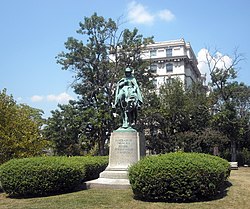
Daniel Chester French was an American sculptor of the late nineteenth and early twentieth centuries, best known for his 1874 sculpture The Minute Man in Concord, Massachusetts, and his 1920 monumental statue of Abraham Lincoln in the Lincoln Memorial in Washington, D.C.
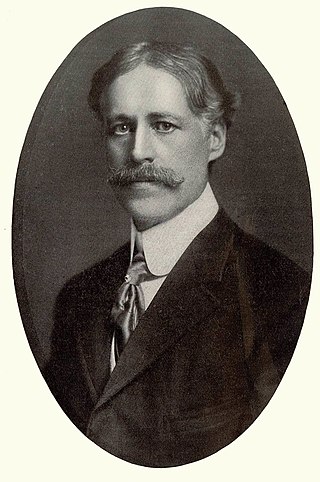
William Ordway Partridge was an American sculptor, teacher and author. Among his best-known works are the Shakespeare Monument in Chicago, the equestrian statue of General Grant in Brooklyn, the Pietà at St. Patrick's Cathedral in Manhattan, and the Pocahontas statue in Jamestown, Virginia.
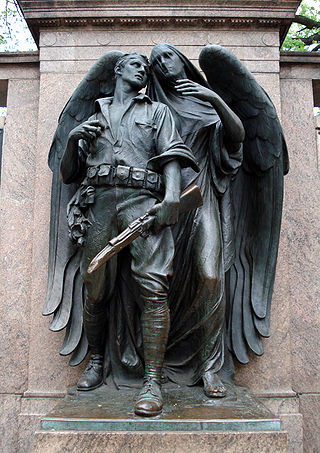
Henry Augustus Lukeman was an American sculptor, specializing in historical monuments. Noted among his works are the World War I monument in Prospect Park, Brooklyn, the Kit Carson Monument in Trinidad, Colorado and the Stone Mountain Confederate Memorial in Georgia.

Cyrus Edwin Dallin was an American sculptor best known for his depictions of Native Americans. He created more than 260 works, including the Equestrian Statue of Paul Revere in Boston; the Angel Moroni atop Salt Lake Temple in Salt Lake City; and Appeal to the Great Spirit (1908), at the Museum of Fine Arts, Boston. He was also an accomplished painter and an Olympic archer.
Sherry Edmundson Fry was an American sculptor, who also played a prominent role in U.S. Army camouflage during World War I.
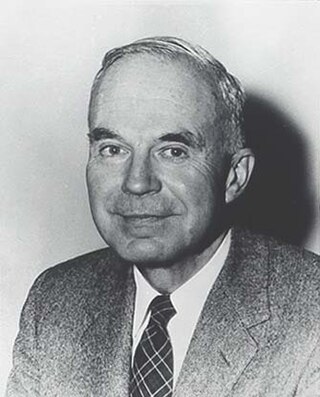
Walker Kirtland Hancock was an American sculptor and teacher. He created notable monumental sculptures, including the Pennsylvania Railroad World War II Memorial (1950–52) at 30th Street Station in Philadelphia, and the World War I Soldiers' Memorial (1936–38) in St. Louis, Missouri. He made major additions to the National Cathedral in Washington, D.C., including Christ in Majesty (1972), the bas relief over the High Altar. Works by him are presently housed at the U.S. Military Academy at West Point, the Library of Congress, the U.S. Supreme Court, and the United States Capitol.
Roman Bronze Works, now operated as Roman Bronze Studios, is a bronze foundry in New York City. Established in 1897 by Riccardo Bertelli, it was the first American foundry to specialize in the lost-wax casting method, and was the country's pre-eminent art foundry during the American Renaissance.

Zenos Frudakis, known as Frudakis, is an American sculptor whose diverse body of work includes monuments, memorials, portrait busts and statues of living and historic individuals, military subjects, sports figures and animal sculpture. Over the past four decades he has sculpted monumental works and over 100 figurative sculptures included within public and private collections throughout the United States and internationally. Frudakis currently lives and works near Philadelphia, and is best known for his sculpture Freedom, which shows a series of figures breaking free from a wall and is installed in downtown Philadelphia. Other notable works are at Arlington National Cemetery in Virginia, Brookgreen Gardens in South Carolina, the National Academy of Design, and the Lotos Club of New York City, the Imperial War Museum in England, the Utsukushi ga-hara Open Air Museum in Japan, and the U.S. Embassy in Pretoria, South Africa.
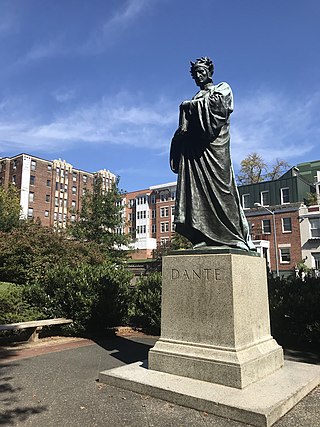
Dante Alighieri, is a public artwork by Italian artist Ettore Ximenes, located at Meridian Hill Park in Washington, D.C., United States. Dante Alighieri was originally surveyed as part of the Smithsonian Institution's Save Outdoor Sculpture! survey in 1994. The monument is a tribute to Italian poet Dante Alighieri.

Major General John A. Logan, also known as the General John A. Logan Monument and Logan Circle Monument, is an equestrian statue in Washington, D.C. that honors politician and Civil War general John A. Logan. The monument is sited in the center of Logan Circle, a traffic circle and public park in the Logan Circle neighborhood. The statue was sculpted by artist Franklin Simmons, whose other prominent works include the Peace Monument and statues in the National Statuary Hall Collection. The architect of the statue base was Richard Morris Hunt, designer of prominent buildings including the Metropolitan Museum of Art in New York City and The Breakers in Newport, Rhode Island. Prominent attendees at the dedication ceremony in 1901 included President William McKinley, members of his cabinet, Senator Chauncey Depew, Senator Shelby Moore Cullom, and General Grenville M. Dodge.

Major General James B. McPherson is a public artwork by American artist Louis Rebisso, located at McPherson Square in Washington, D.C., United States. Major General James B. McPherson was originally surveyed as part of the Smithsonian's Save Outdoor Sculpture! survey in 1993. The monument is a bronze equestrian statue of Civil War hero James B. McPherson. The statue is a contributing monument to the Civil War Monuments in Washington, DC, of the National Register of Historic Places.

General Philip Sheridan is a bronze sculpture that honors Civil War general Philip Sheridan. The monument was sculpted by Gutzon Borglum, best known for his design of Mount Rushmore. Dedicated in 1908, dignitaries in attendance at the unveiling ceremony included President Theodore Roosevelt, members of the President's cabinet, high-ranking military officers and veterans from the Civil War and Spanish–American War. The equestrian statue is located in the center of Sheridan Circle in the Sheridan-Kalorama neighborhood of Washington, D.C. The bronze statue, surrounded by a plaza and park, is one of eighteen Civil War monuments in Washington, D.C., which were collectively listed on the National Register of Historic Places in 1978. The sculpture and surrounding park are owned and maintained by the National Park Service, a federal agency of the Interior Department.

Major General Marquis Gilbert de Lafayette is a statue in the southeast corner of Lafayette Square, in Washington, D.C., near the junction of Pennsylvania Avenue with Madison Place and close to the White House. The statue was erected in 1891 to honor Gilbert du Motier, Marquis de Lafayette and his contribution in the American Revolutionary War. The square, originally part of the President's Park, was named in honor of the Marquis in 1824. The statuary was made by Alexandre Falguière and Antonin Mercié, and the architect who designed the marble pedestal was Paul Pujol..

Major General George Henry Thomas, also known as the Thomas Circle Monument, is an equestrian sculpture in Washington, D.C. that honors Civil War general George Henry Thomas. The monument is located in the center of Thomas Circle, on the border of the downtown and Logan Circle neighborhoods. It was sculpted by John Quincy Adams Ward, best known for his work on the statue of George Washington in Wall Street, Manhattan. Attendees at the dedication in 1879 included President Rutherford B. Hayes, Generals Irvin McDowell, Philip Sheridan, and William Tecumseh Sherman, senators and thousands of soldiers.

Equestrian Statue of Theodore Roosevelt is a 1939 bronze sculpture by James Earle Fraser. It was located on public park land at the American Museum of Natural History, New York City. The equestrian statue depicts Theodore Roosevelt on horseback. Walking on either side of him are two men, on one side a Native American and on the other, a sub-Saharan African.
Neil Carl Estern was an American sculptor. Known for his public monuments, Estern's best-known works are his sculptures of Franklin D. Roosevelt, Eleanor Roosevelt, and Fala at the Franklin Delano Roosevelt Memorial in Washington. Estern was also the creator of Patti Playpal.

The Ulysses S. Grant Monument is a presidential memorial in Chicago, honoring American Civil War general and 18th President of the United States Ulysses S. Grant. Located in Lincoln Park, the statue was commissioned shortly after the president's death in 1885 and was completed in 1891. Several artists submitted sketches, and Louis Rebisso was selected to design the statue, with a granite pedestal suggested by William Le Baron Jenney. At the time of its completion, the monument was the largest bronze statue cast in the United States, and over 250,000 people were present at the dedication.

George Washington is an outdoor equestrian statue by the Scottish-American sculptor J. Massey Rhind located in Washington Park in Newark, New Jersey. It depicts General George Washington saying farewell to the troops of the Continental Army on November 2, 1783, and was dedicated on the anniversary of that event in 1912.

Major General David McMurtrie Gregg is a monumental statue located in Reading, Pennsylvania, United States. The monument was designed by Henry Augustus Lukeman and consists of an equestrian statue depicting David McMurtrie Gregg, a military officer who had served in the Union Army during the American Civil War. The monument was dedicated in 1922, several years after Gregg's death in Reading in 1916.
